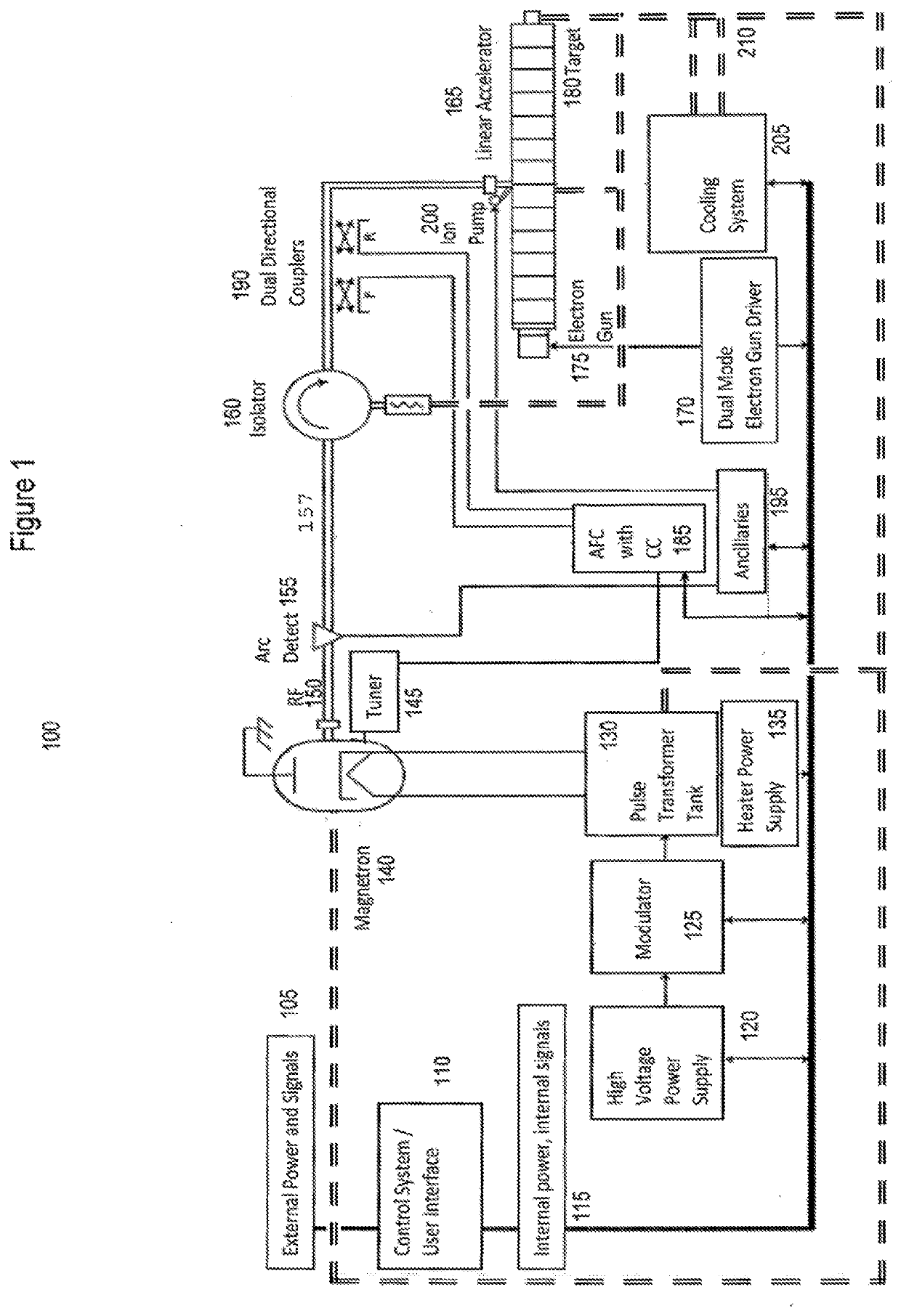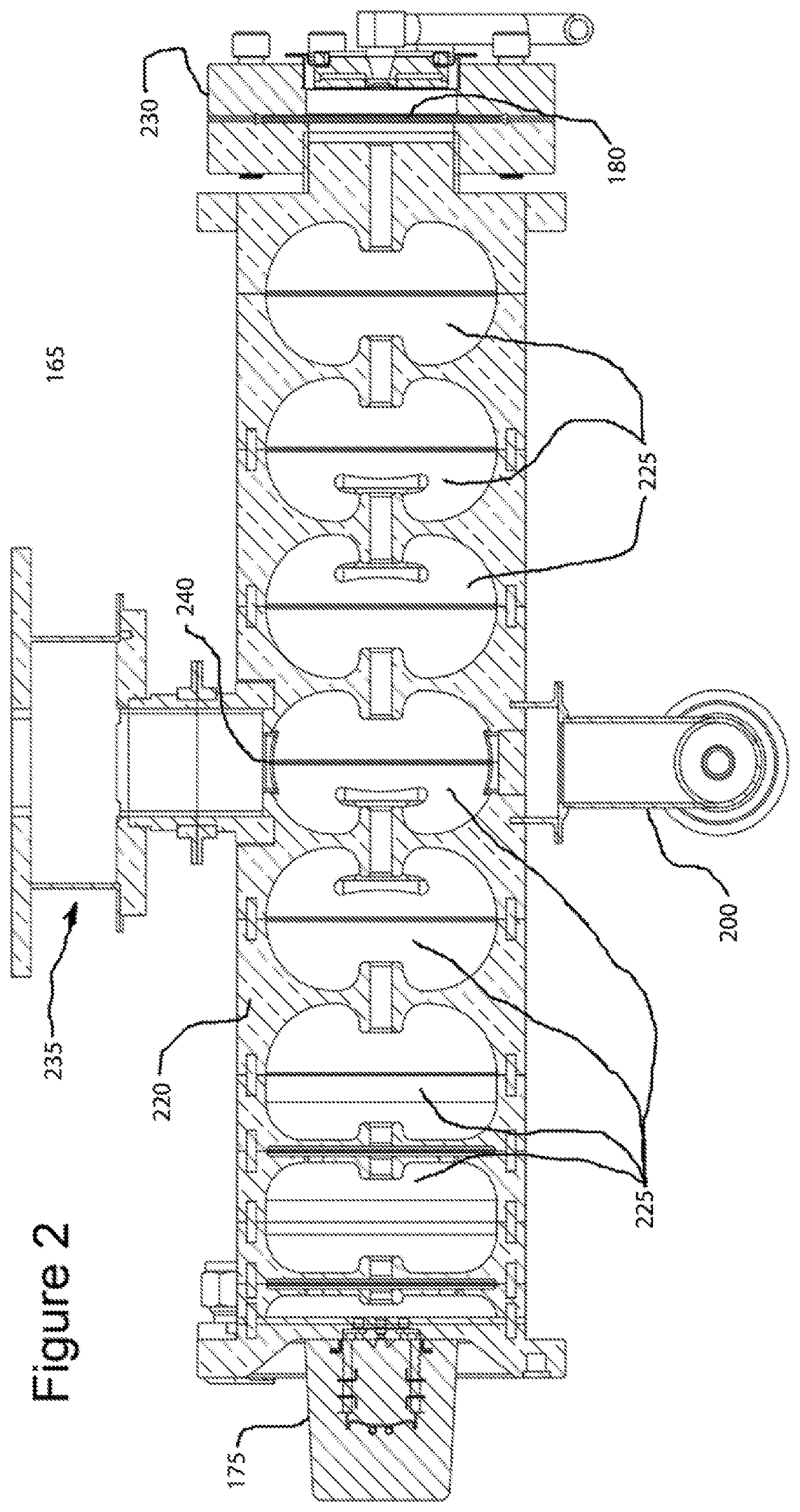In addition, the Q of the linac can affect the performance of the
system.
However, it is impractical to take a first scan of a container resting on the
bed of a
truck at a first X-ray energy, and then take a second, later scan of that same container at a second X-ray energy.
This
interleaving, however, can present challenges to a linac
system since the performance of a linac with its resonant structure is highly dependent on a good frequency match.
These techniques have been sufficient when the time between energy changes is long, such as seconds or many seconds, but have been less effective when the time between energy changes is a fraction of a second.
However, detuning can cause instabilities in performance, and is difficult to do in a fraction of a second if a mechanically-tuned magnetron is the RF source.
A challenge with applying prior art techniques for changing linac energy on a rapid time scale in an ABABABAB fashion can be the undesired corresponding detuning of the RF source.
For example, in addition to intentional tuning, reducing or increasing RF power from a magnetron typically results in a change in frequency of the RF output.
If the frequency change is large enough, the linac's
resonance is no longer matched to the frequency of the
RF excitation pulse, and the system fails to operate.
Because of the sensitivity of linac-based systems to changes in frequency, the prior art has generally not been able to provide a fully optimized
train of stable, interleaved pulses of different energies such as an ABABABABAB (etc.) pattern, especially where the energy must be changed rapidly, from one pulse to the next, at a 2.5-
millisecond basis or shorter such as required for a
pulse rate of 400 or more pulses per second, and especially when that rapid change is done with a magnetron driven system
This limits the ability to rapidly switch a magnetron system between higher and lower energy levels while still maintaining a frequency match with the linac, because the magnetron frequency will shift upon a power change and a mechanical
tuner simply cannot be moved rapidly enough to support a 2.5
millisecond or shorter period between pulses.
One drawback of a magnetron is that its mode and stability can become unfavorable if the magnetron is operated at a peak power too much different from its optimum or maximum peak power.
However, as noted before, changing the
power output of the magnetron also causes a change to the output frequency of the RF pulse, such that the output frequency of the magnetron can be a mismatch for the linac.
Changing this current by many amperes may cause a significant detuning with respect to the
resonance of a given linac.
While AFC circuits can compensate for long term changes in frequency, such circuits are not intended to compensate for instantaneous pulse-to-pulse changes such as occur with a magnetron is driven with an alternating sequence that varies by several amps.
As a result, such approaches can result in
instability of the magnetron-linac system, and there has been a need for a system and technique for maintains stability while permitting the use of interleaved pulses of different RF powers to generate an interleaved pattern of X-ray pulses of different energies.
In addition to the challenges to prior art systems that result from variations in RF matching between the output frequency of a magnetron and the resonant frequency of the linac, the prior art has also had challenges in maintaining a consistent
dose from pulse to pulse when interleaved pulses of different energies are generated.
However, for the use of X-rays to differentiate among materials, as required for
cargo scanning applications, such changes in
dose per pulse are undesirable.
While dose control in medical applications can be achieved through changes in repetition rate, this is not desirable for cargo scanning applications which depend upon having consistent repetition rates.
A further problem in cargo scanning applications is the intermittent nature of the operation of such scanning systems.
While this affects only the first few pulses, or 10 pulses or more after scanning is re-initiated, before the AFC circuit can achieve a good match, this lack of consistency in output energy and / or dose can affect the quality of the resulting images, and is therefore undesirable.
These warm-up approaches have the significant
disadvantage of potentially generating some amount of X-rays even when the
electron gun is not being pulsed.
Another
disadvantage is the consumption of average power that is not used for the generation of X-rays.
These approaches are inefficient and therefore undesirable.
 Login to View More
Login to View More  Login to View More
Login to View More 


